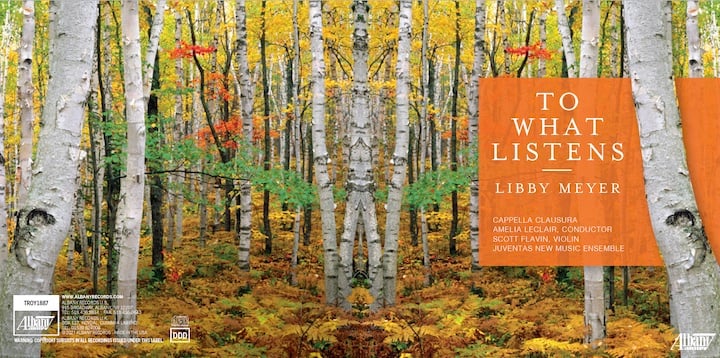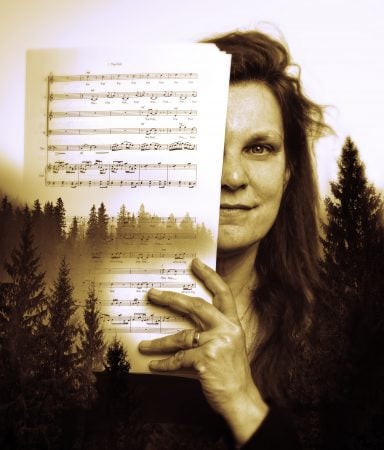The Keweenaw is awash in the sounds of nature. The cold north wind whistling through the birch trees at Fort Wilkins. The waves of Lake Superior slapping the agates along Bete Gris. The water whooshing through the rocks at Hungarian Falls. The loons conversing at dusk against the red and orange brilliance of the sky. It is the place for Libby Meyer, a teaching professor in Michigan Technological University’s visual and performing arts department and director of the music composition program, to create her art. To draw inspiration from her surroundings. “By giving a voice to the landscape and its inhabitants, my hope is to express this fragile relationship that we all share and need to sustain.”
You can hear that voice clearly in her latest CD release To What Listens. The CD project was funded by a grant from the University’s Research Excellence Fund Scholarship and Creativity Grants program. The recordings of choral and chamber works on Albany Records feature performances from the Capella Clausura conducted by Amelia LeClair and the Juventas New Music Ensemble.
The CD opens with “For Johnny B,” an arrangement of a movement from Lakescape, an orchestral work commissioned by the Keweenaw Symphony Orchestra and funded by a grant from the National Endowment for the Arts and the National Park Service in honor of the 100th Anniversary of the National Park Service. “For Johnny B” celebrates the Keweenaw National Historical Park. The lyrics were crafted from an oral history of Giovanni “Johnny” Battista Perona, a farmer, laborer, custodian, master musician on spoons, bones, and concertina as well as a butterfly enthusiast from Calumet.
In “Melusina Calls to the Loon,” Libby captures the sounds of life on Isle Royale National Park, where she was an artist in residence in 1999. On walks, Libby would make up stories to fit the sounds surrounding her. On one particular walk, she imagined a melancholy conversation between a mermaid and a loon, each enchanted by the music of the other.
The title track “To What Listens” is a set of five poems by Wendell Berry, poet, farmer, and environmental activist. These brief poems give birds a voice and use music inspired by bird songs, reminding us only by being fully present can we appreciate the beauty that is right now. The liner notes encourage, “Habitat loss is causing the woods to become quieter, so it is more important than ever that we listen to ‘the hidden singers.”
From Violin Lessons to Performances to Composition
Her music career started early with violin lessons from her musician father. Passion for music burned. She pursued a degree in music performance at Michigan State, but a broken arm made playing the violin painful. Instead, she started to compose and switched her major to theory and composition.
Composing was never presented to me as an option. It was something other people did and not a lot of other people did it. However, I realized that a bachelor’s in composition was less than worthless, so I decided to apply to grad school and I got in.
Northwestern offered Libby a full ride. “Chicago had great opportunities with lots of music, so it seemed like a great choice,” she says. Libby loved the energy of living in Chicago and the activity the city offered. “There is a lot of concrete in Chicago.”
Libby Meyer Finds Her Home in the Upper Peninsula
It wasn’t long before she decided to trade the concrete of Chicago for the timbers of the Upper Peninsula. “I had the great fortune to be selected as an artist in residence at Isle Royale National Park. I didn’t know it at the time, but it would become a life-altering experience. One that inspired me to leave Chicago without any real plan and move to the U.P. where I now make my home these many years later. Upon arrival at the park, I was immediately fascinated by the novel sights and sounds all around me; so different from the soundscapes of Chicago. It was here that I heard a white-throated sparrow for the first time and was so transfixed that I spent the following weeks trying to identify all the sounds that I was hearing. Each night walking from my cabin I would hear the calls of the loons, the chattering of squirrels, the chirping of frogs, bird songs, and the motion of Lake Superior.”
That the great outdoors has become her muse is no surprise given her introduction to it on Isle Royale. She admits it is hard to separate her work from the Keweenaw, whether it’s bugs in the summer or snow the other nine months of the year. Or the lake. “The lake is my little nirvana,” she says. It inspires her to create new sounds.
New sounds are a welcome addition to the local community of talented musicians. They are always willing to play something new and different. “If I write something I can get it played. The best thing about being a composer is writing something and having someone play it,” she says. It is just one of the joys of being a musician in this place.
The Joys Music Brings to Libby
In talking to her, it is clear music is front and center. She loves to see what she can do with music. Libby creates her own music and sounds, using what she hears in nature for inspiration. Here in Houghton, the inspiration is unencumbered by the white noise of the big city. Plus, Michigan Tech offers other advantages to being a composer. If she writes something she is confident it can be played. And writing something and hearing it played brings her the most joy.
Another joy for Libby is nurturing music in her students; seeing the excitement they get by writing music. She loves how curious and creative the students are; especially since most downplay their creativity. For Libby “Art is less a creation and more an allowing.” Students need that space where they are allowed to create. And particularly here at Michigan Tech where most pursue studies outside of music. “Students here get opportunities to play they would never get anywhere else.” It makes her feel like an ambassador.
Libby loves finishing a piece. When she starts a piece, she never really knows how it is going to go. Seeing it come together is really satisfying. For example, Libby was asked to write a piece to commemorate the 200th anniversary of Frederick Law Olmsted’s (social reformer and founder of American landscape architecture) birth. Given her love of Michigan, she chose to compose a piece about Belle Isle, a park in Detroit designed by Olmsted. While doing the research, she learned Olmsted quit the project. Instead, she decided to focus on the native wildflowers Olmsted incorporated into his landscape designs. It became “Beauty of the Fields.” Listen to Libby talk about Belle Isle and “Beauty of the Fields.”
Finishing To What Listens was a bit of a challenge for Libby. Getting musicians together to rehearse and record in a studio during a pandemic was never going to be easy. However, Libby was patient and determined. And now she can add finishing To What Listens to the list. We cannot wait to hear what new sounds Libby creates and adds to her list of created works.

